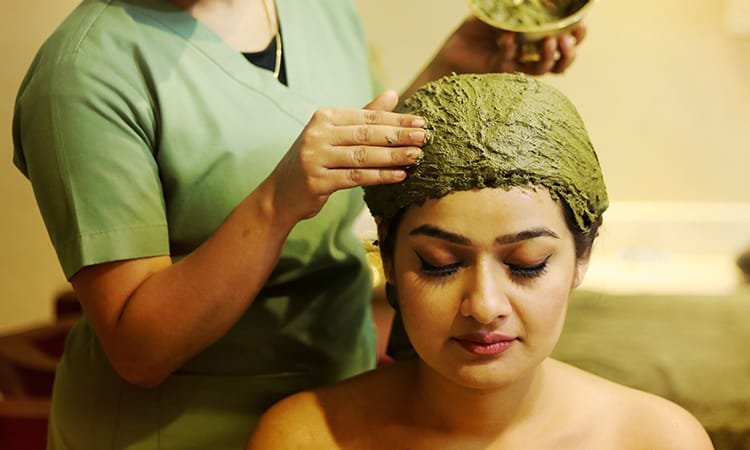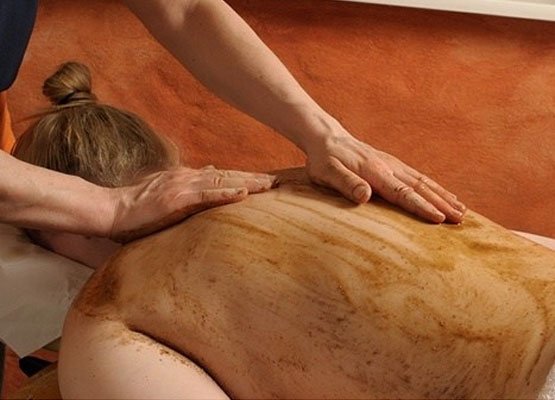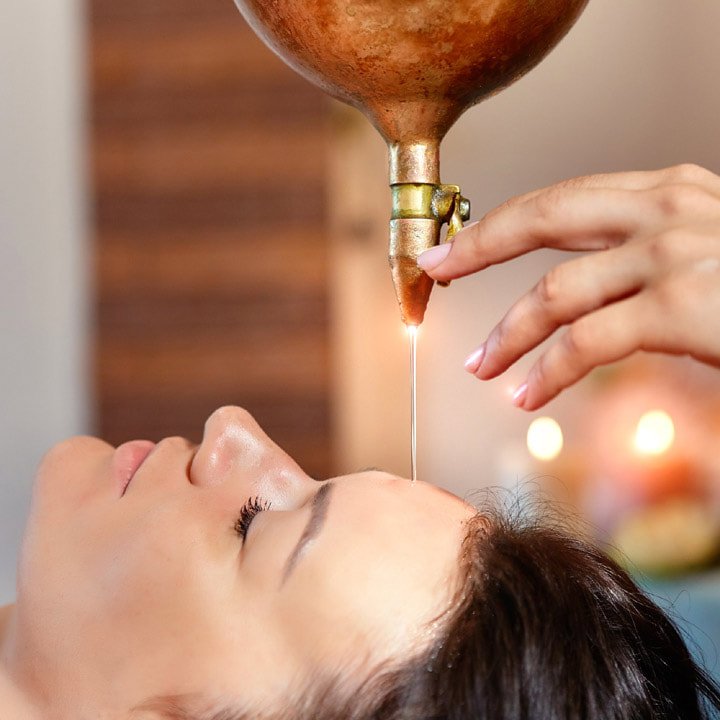Stress Relief through Ayurveda
Clinical Outcomes of Herbal, Manual and Mind–Body Therapies at Arabian Herbals Ayurvedic Centre
Integrative Approaches to Stress Relief: An Ayurvedic Perspective
Ayurveda views stress as an imbalance not only of the mind but of the body’s vital energies—Vata, Pitta, and Kapha. When daily pressures, poor sleep, or dietary indiscretions disturb these doshas, the nervous system becomes overstimulated, leading to symptoms such as anxiety, insomnia, digestive upset, and chronic fatigue.
Traditional Ayurvedic wisdom counters this cascade with a holistic approach: gentle herbal adaptogens like Ashwagandha and Brahmi calm the mind; soothing oils in Abhyanga (self-massage) restore nervous equilibrium; and mindful breathing techniques regulate prana, or life force. By addressing the root energetic imbalances rather than just the surface symptoms, Ayurveda fosters long-term resilience, helping you move from a state of frazzled tension back toward centered calm.
At Arabian Herbals Ayurvedic Centre, we combine centuries-old Ayurvedic methodologies with individualized care to guide you toward sustainable stress relief. Your journey begins with a thorough consultation—evaluating your doshic makeup, lifestyle habits, and stress triggers—to craft a tailored regimen of herbal remedies, dietary recommendations, and daily rhythms.
Our therapists are trained in specialized treatments such as Shirodhara, where a gentle stream of warm herbal oil soothes the third eye center, and Swedana, an herbal steam therapy that releases deep-seated tensions. Complementing these hands-on therapies, we offer stress-modulating yoga sessions, guided pranayama, and meditation classes. Together, these time-tested practices not only alleviate immediate stress but also strengthen your body’s innate capacity to adapt, so you can face life’s challenges with poise and vitality.
Comprehensive Ayurvedic Stress-Relief Treatments at Arabian Herbals Ayurvedic Centre
1. Diagnostic & Assessment
– Purpose: Identify your unique Prakriti (constitution) and Vikriti (current imbalance)
– Includes: Pulse diagnosis, tongue & eye examination, lifestyle interview
– Outcome: A customized treatment roadmap targeting your specific stress-drivers
2. Panchakarma & Detoxification
– Purpose: Eliminate accumulated toxins (Ama) that aggravate the nervous system
– Includes:
Vamana (therapeutic emesis)
Virechana (purgation)
Basti (medicated enemas)
Nasya (herbal nasal administration)
Raktamokshana (blood-letting, as needed)
3. Oil-Based External Therapies
– Purpose: Soothe Vata and calm the mind through warm, medicated oils
– Key Treatments:
Abhyanga (full-body oil massage)
Shirodhara (continuous forehead oil pour)
Kati Basti (lower-back oil pool)
Pizhichil (“royal” warm oil bath)
4. Heat & Steam Therapies
– Purpose: Open channels (srotas), enhance oil absorption, relieve muscular tension
– Key Treatments:
Swedana (herbal steam)
Sirovasti (scalp oil cap with heat)
5. Herbal & Nutraceutical Support
– Purpose: Internally balance stress-hormones and nourish the nervous system
– Includes: Tailored formulations of
Adaptogens: Ashwagandha, Jatamansi, Brahmi
Rejuvenatives: Shatavari, Gotu Kola
Digestive tonics: Trikatu, Triphala
6. Marma & Energy Therapies
– Purpose: Unblock and harmonize subtle energy points for deep relaxation
– Includes:
Marma massage (vital-point stimulation)
Pranic healing
Acupressure Jeevadhara
7. Mind–Body Practices
– Purpose: Build long-term stress resilience through self-regulation
– Includes:
Pranayama (Nadi Shodhana, Bhramari)
Guided Meditation (mindfulness, chakra balancing)
Therapeutic Yoga (dosha-specific asanas)
8. Lifestyle & Dietary Counseling
– Purpose: Reinforce in-centre gains with daily habits
– Includes:
Dinacharya (daily routine planning)
Ritucharya (seasonal adjustments)
Dosha-balancing meal plans and herbal teas
Sleep hygiene & stress-reducing rituals
Everyday Relax
Rediscover Inner Serenity: Holistic Ayurvedic Stress Management at Arabian Herbals Ayurvedic Centre
In today’s fast-paced world, stress has become an almost constant companion—triggering a cascade of physical tensions, emotional imbalances, and disrupted sleep. At Arabian Herbals Ayurvedic Centre, we believe true relief emerges when we address the root causes of stress—imbalance in the body’s vital energies (doshas)—rather than simply masking symptoms. Drawing on centuries-old Vedic wisdom, our integrative approach weaves together personalized assessments, targeted therapies, and lifestyle guidance to guide you back to a state of lasting calm and resilience.
Understanding Stress Through an Ayurvedic Lens
Ayurveda views stress not as an isolated mind-only phenomenon, but as a disharmony among Vata, Pitta, and Kapha.
-
Vata Imbalance often manifests as racing thoughts, anxiety, and insomnia—your nervous system is overstimulated and erratic.
-
Pitta Imbalance brings irritability, frustration, and inflammation—your “inner fire” is overheated.
-
Kapha Imbalance shows up as heaviness, lethargy, and depression—your energy channels are sluggish.
Our first step is a detailed Tridoshic Assessment, combining pulse diagnosis, tongue and eye examination, and an in-depth lifestyle interview. This lets our Vaidya pinpoint exactly which doshic pattern is fueling your stress so that every subsequent therapy is tailor-made for your unique constitution.
Signature Stress-Relief Therapies
-
Abhyanga & Pizhichil (Oil-Based Therapies)
A continuous, warm herbal oil massage (Abhyanga) followed by the “royal oil bath” (Pizhichil) melts away muscle tension and anchors an overactive mind. The soothing strokes and nourishing oils calm Vata and Pitta, promote circulation, and invite deep relaxation. -
Shirodhara & Sirovasti (Head Therapies)
A gentle stream of herbal oil dripped across the forehead (Shirodhara) or held at the scalp within a cap (Sirovasti) allows your nervous system to reset. These treatments are legendary for alleviating chronic headaches, insomnia, and mental fatigue—bringing you into a meditative stillness. -
Nasya & Pratimarsha Nasya (Nasal Therapies)
By administering medicated oils or herbal ghee into the nasal passages, we clear mental fog, soothe anxiety, and stabilize stress hormones. This direct channel to the brain calms racing thoughts and supports restful sleep. -
Swedana & Udwarthanam (Heat & Powder Therapies)
Herbal steam (Swedana) opens pores to enhance oil absorption and relax tight muscles. Udwarthanam—a vigorous herbal powder massage—boosts circulation, mobilizes lymphatic stagnation, and uplifts the spirit with its warming action. -
Marma Point Therapy & Pranic Healing
Gentle stimulation of vital energy points (marma) unblocks stagnant prana, restoring the smooth flow of life force. Paired with guided pranic breathing exercises, this helps you cultivate calm from within and carry it into daily life.
Supporting Your Journey: Herbs, Yoga & Nutrition
Alongside our hands-on treatments, we prescribe bespoke Herbal Formulations—adaptogens like Ashwagandha to buffer stress, Brahmi for mental clarity, and Jatamansi to soothe the nervous system. Daily Pranayama (breathwork) and Meditation sessions equip you with techniques to neutralize tension on the spot, while Therapeutic Yoga asanas restore balance to your body and mind. Complementing these practices, our dietary coaches design nourishing, dosha-balancing meal plans that stabilize blood sugar, calm inflammation, and support a resilient nervous system.
Real Results, Lasting Resilience
Clients often arrive feeling overwhelmed, exhausted, or emotionally “stuck.” By the end of a personalized program—typically 7 to 21 days—many report profound shifts:
-
Deeper, more restorative sleep
-
Reduced anxiety and clearer thinking
-
Soothed muscular tension and improved posture
-
A newfound ability to face life’s challenges with equanimity
These transformations arise not from quick fixes, but from realigning your body’s inherent rhythms and strengthening your natural stress-management capacity.
Ready to Experience True Stress Relief?
At Arabian Herbals Ayurvedic Centre, we invite you to step off the treadmill of modern life and rediscover inner calm through the time-tested science of Ayurveda. Contact us today to schedule your Tridoshic Assessment and embark on a journey toward balanced energy, mental clarity, and sustained well-being.
What are the best Ayurvedic herbs for stress relief?
Some effective herbs include Ashwagandha, Brahmi, Shankhpushpi, and Jatamansi. These herbs help reduce anxiety, improve sleep, and promote relaxation.




